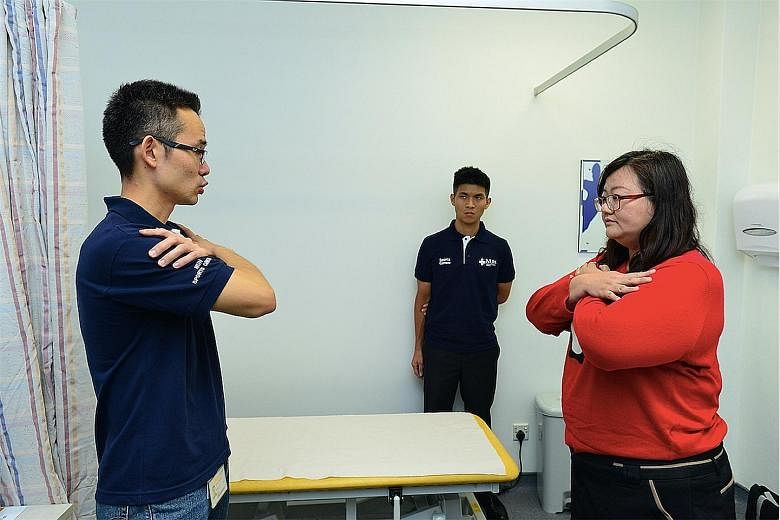As daunting as a 23km ride might sound to a beginner cyclist, preparation is key to conquering the challenge.
With two months to go till the Nov 18-19 OCBC Cycle, it is all down to the participants to put in the hours to get themselves ready.
Physiotherapist Jeremy Mok from the National University Hospital (NUH) Sports Centre estimated a beginner cyclist would require about 11/2 hours to complete the 23km distance.
To build up the fitness required to cover the distance, "you'd probably have to start riding for 20-30 minutes and slowly build it up to an hour and half", said the 29-year-old at the OCBC Cycle's injury management talk yesterday.
"You have to spend that duration first to get your body used to the glycogen and energy, and to prevent injury."
The rider also has to acclimatise in terms of "saddle time" as the body and posture get used to the duration.
The two-hour talk touched on race preparation, overuse issues - such as handlebar palsy, cyclist's knee and the iliotibial band - and simple remedies for those problems, bike fitting and cycling-related traumatic injuries.
-
COMMON CYCLING OVERUSE INJURIES
-
HANDLEBAR PALSY
Symptom: Numbness and tingling of the ring and little finger.
Cause: Prolonged gripping of the handlebars which exerts direct pressure on the ulnar nerve (near the elbow)
Prevention: Wear padded gloves and avoid extending your wrists for too long
CYCLIST'S KNEE
Symptom: Pain over the front of the knee during downstroke.
Cause: Excessive repeated rubbing of the knee cap against the thigh bone
Prevention: Get a professional bike fit to ensure your seat height is not too low or too far forward. Do more hip-strengthening exercises.
ILIOTIBIAL BAND
Symptom: Pain over the outer part of the knee when flexed at 30 degrees.
Cause: Excessive friction between the connective tissue of the outer thigh and a bony prominence of the thigh bone.
Prevention: Get a professional bike fit to ensure your seat is not too high or cleats are not too close together. Do more exercises to stretch and strengthen your hip muscles.
• Information from NUH Sports Centre
Among the 50 participants was 39-year-old Christine Lim, who is part of OCBC Cycle's Project Training Wheels, the event's learn-to-ride programme.
"It's important for Christine to start going to the gym for stationary cycling, and spending the same amount of time for a start," said Mok. "It's very specific to cycling and still works your body system."
However, Lim's preparations are not as straightforward as over the years, she had picked up a lower back problem and suffered from a right knee injury. A graphic designer by trade, she also spends long hours sitting down which aggravates her problems.
"When I get up, I feel pain, my whole body feels stiff. This has been quite an obstacle, I don't feel like I'm myself so I stopped exercising," said Lim. "I dare not do vigorous activities for fear of injuring myself again."
That was when her husband suggested picking up cycling as "it'll have less impact on my injuries".
Mok also suggested simple circuit exercises and leg strengthening at a gym for her preparations.
He said: "For leg strengthening - everything from the calves, quads, hamstrings and glutes (needs to be worked on).
"The duration plays a part, so anything from half an hour to an hour of strength exercise can be useful."
Lim also underwent a medical examination by Mok and Dr Wang Mingchang, a family physician at the NUH Sports Centre.
Lim said: "I had a relapse in February and I was limping because of pain in the legs and back. I'd feel sore and painful during cycling."
Dr Wang's examination focused on Lim's two areas of discomfort - her lower back and right leg.
"Her pain was actually worse after sitting for long periods and when she gets up, it's associated with a lot of muscle tightness," said Dr Wang, 35. "The pain runs down the right side of her thigh and calf, there is weakness but no numbness."
She was advised to work on her posture, stretch and get some manual release for her tight muscles.
They recommended that she take standing breaks or sit up straight with shoulders back every 30 minutes to help with her back pain. Stretches to loosen tight muscles (like a figure four while lying down) were also demonstrated to her. Lastly, Lim's husband, Wallace Tan, was also taught how to perform manual release on Lim, which could loosen her muscles.
"The main thing I've learnt today is to be careful while cycling," said Lim. "If I feel any pain in my back or legs, I must adjust my posture."
Lim also purchased a hybrid bicycle and will be using it for her last Project Training Wheels session on Sept 30 at East Coast Park.
"I'm more confident now and even went to the stadium for a 45-minute cycling session. I think I can finish the ride, I must do it."

